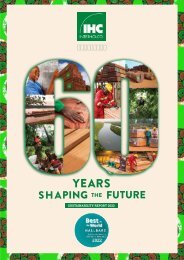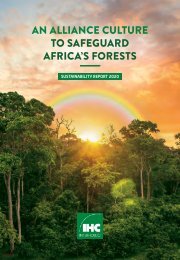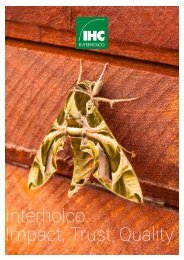Nomenclature Générale des Bois Tropicaux - 7ème édition
(english description below) Cette nomenclature est utilisée pour la mise à jour du 'Harmonized Code System' de l’Organisation Mondiale des Douanes. Dans la circulaire du 5 avril 2005, le Ministère de l’Economie, des Finances et de l’Industrie (France) reconnaît l’ATIBT comme « gardien du temple » de la nomenclature des bois tropicaux. La Commission Européenne mentionne la nomenclature de l’ATIBT comme document de référence pour la mise en œuvre du RBUE. Depuis 1954, l’ATIBT a établi et mis à jour une nomenclature des bois tropicaux faisant correspondre chaque espèce botanique avec un nom pilote reconnu internationalement. La détermination du nom pilote d’une essence est cruciale, car sa commercialisation dépend très largement de l’adoption de ce nom par le public. Le nom pilote assure la protection de l’appellation commerciale de l’essence et l’intégrité des propriétés qui lui sont attribuées, sans risque de confusion. The 1982 version of the general timber nomenclature has finally been updated as some of the 1,750 identified species, are no longer traded, while others, which were not previously included, are now on the market. The present revision has also integrated changes related to new taxonomy, in order to reflect the latest scientific developments. This Nomenclature has been used for the Harmonized Code System, updated by the World Customs Organization. The French Ministry of economy, finance and industry has given official recognition to ATIBT as the reference for the tropical timber nomenclature (NOR: PRMX0508285C of April 5th 2005). The European Commission refers to ATIBT nomenclature as a reference document for the implementation of the EUTR regulation. Since 1954, ATIBT has established and updated a nomenclature of tropical wood, linking each botanical species with an internationally recognized pilot name. A sigle wood species may have many common names; when trading across different countries, this may lead to confusion. Fixing the pilot name of a timber species is crucial, to protect the commercial denomination of the species and guarantee the veracity of the properties linked to that species, without confusion.
(english description below)
Cette nomenclature est utilisée pour la mise à jour du 'Harmonized Code System' de l’Organisation Mondiale des Douanes. Dans la circulaire du 5 avril 2005, le Ministère de l’Economie, des Finances et de l’Industrie (France) reconnaît l’ATIBT comme « gardien du temple » de la nomenclature des bois tropicaux. La Commission Européenne mentionne la nomenclature de l’ATIBT comme document de référence pour la mise en œuvre du RBUE.
Depuis 1954, l’ATIBT a établi et mis à jour une nomenclature des bois tropicaux faisant correspondre chaque espèce botanique avec un nom pilote reconnu internationalement. La détermination du nom pilote d’une essence est cruciale, car sa commercialisation dépend très largement de l’adoption de ce nom par le public. Le nom pilote assure la protection de l’appellation commerciale de l’essence et l’intégrité des propriétés qui lui sont attribuées, sans risque de confusion.
The 1982 version of the general timber nomenclature has finally been updated as some of the 1,750 identified species, are no longer traded, while others, which were not previously included, are now on the market. The present revision has also integrated changes related to new taxonomy, in order to reflect the latest scientific developments.
This Nomenclature has been used for the Harmonized Code System, updated by the World Customs Organization. The French Ministry of economy, finance and industry has given official recognition to ATIBT as the reference for the tropical timber nomenclature (NOR: PRMX0508285C of April 5th 2005). The European Commission refers to ATIBT nomenclature as a reference document for the implementation of the EUTR regulation.
Since 1954, ATIBT has established and updated a nomenclature of tropical wood, linking each botanical species with an internationally recognized pilot name. A sigle wood species may have many common names; when trading across different countries, this may lead to confusion. Fixing the pilot name of a timber species is crucial, to protect the commercial denomination of the species and guarantee the veracity of the properties linked to that species, without confusion.
Create successful ePaper yourself
Turn your PDF publications into a flip-book with our unique Google optimized e-Paper software.
Liste des noms scientifiques des bois tropicaux avec renvoi au nom pilote /// 33
NOM BOTANIQUE
BOTANICAL NAME
FAMILLE
FAMILY
CONTI-
NENT
Madhuca betis J.F. Macbr. Sapotaceae AS Bitis
Madhuca burckiana H.J. Lam Sapotaceae AS Nyatoh
Madhuca malaccensis H.J. Lam Sapotaceae AS Nyatoh
Madhuca motleyana J.F. Macbr. Sapotaceae AS Nyatoh
Madhuca utilis H.J. Lam Sapotaceae AS Bitis
Maesopsis eminii Engl. Rhamnaceae AF Musizi
Magnolia spp. (AS) Magnoliaceae AS Champak
Magnolia ovata Spreng. Magnoliaceae AM Baguacù
Malacantha superba Vermoesen (cf. Pouteria
superba)
Sapotaceae AF Aniégré
Mammea africana Sabine Calophyllaceae (Clusiaceae) AF Oboto
Mangifera spp. Anacardiaceae AS Mango
Mangifera foetida Lour. Anacardiaceae AS Mango
Mangifera indica L. Anacardiaceae AS Mango
Mangifera laurina Blume Anacardiaceae AS Mango
Manglietia spp. (cf. Magnolia) Magnoliaceae AS Champak
NOM PILOTE
PILOT NAME
Manilkara spp. (AM) Sapotaceae AM Maçaranduba
Manilkara spp. (AS) Sapotaceae AS Manilkara
Manilkara spp. (AF) Sapotaceae AF Monghinza
Manilkara bidentata A. Chev. Sapotaceae AM Maçaranduba
Manilkara fasciculata H.J. Lam Sapotaceae AS Manilkara
Manilkara huberi Ducke Sapotaceae AM Maçaranduba
Manilkara kauki Dubard Sapotaceae AS Manilkara
Manilkara mabokeensis Aubrév. Sapotaceae AF Monghinza
Manilkara obovata J.H. Hemsl. Sapotaceae AF Monghinza
Mansonia altissima A. Chev. Malvaceae (Sterculiaceae) AF Bété
Maquira sclerophylla C.C. Berg Moraceae AM Muiratinga
Markhamia lutea K. Schum. Bignoniaceae AS Lusambya
Markhamia platycalyx Sprague Bignoniaceae AS Lusambya
Marmaroxylon racemosum Record (cf. Zygia
racemosa)
Leguminosae (Mimosaceae) AM Angelim rajado
Martiodendron elatum Gleason Leguminosae (Caesalpiniaceae) AM Groçai-rosa
Martiodendron excelsum Gleason Leguminosae (Caesalpiniaceae) AM Groçai-rosa
Martiodendron parviflorum R.C. Koeppen Leguminosae (Caesalpiniaceae) AM Groçai-rosa
Mastixiodendron pachyclados Melch. Rubiaceae AS Garo Garo
Mastixiodendron smithii Merr. & L.M. Perry Rubiaceae AS Garo Garo
Melaleuca leucadendron L. Myrtaceae AS Niaouli
Melanorrhoea spp. (cf. Gluta) Anacardiaceae AS Rengas
Melanoxylon brauna Schott Leguminosae (Caesalpiniaceae) AM Braùna
Melia azedarach L. Meliaceae AS Xoan
Melia composita Willd. (cf. M.azedarach) Meliaceae AS Xoan
Mesua ferrea L. Calophyllaceae (Clusiaceae) AS Penaga














